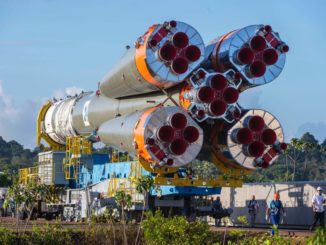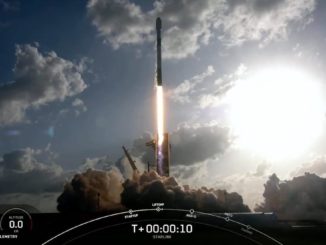今回のH-IIA F38打ち上げは、地表付近では陽炎が凄くて、ゆらゆら揺れて見えましたが、上空に行くとくっきり見えますね。 pic.twitter.com/0zhyRXYvQk
— 柴田孔明 (@koumeiShibata) February 27, 2018
A Japanese H-2A rocket launched Tuesday with a clandestine government-owned satellite to collect sharp-eyed views of North Korea’s missile developments and other global hotspots.
The 174-foot-tall (53-meter) rocket fired its hydrogen-fueled LE-7A main engine and two solid rocket boosters at 0434 GMT Tuesday (11:34 p.m. EST Monday) to fire into space from the Tanegashima Space Center, a launch base carved into a rocky oceanfront outcrop on an island off Japan’s southwestern coast.
Propelled by 1.4 million pounds of thrust, the H-2A rocket climbed through a clear afternoon sky at Tanegashima, where launch occurred at 1:34 p.m. local time Tuesday.
The two solid rocket boosters consumed their pre-packed propellants in less than two minutes before falling away to plummet into the Pacific Ocean. The H-2A’s nose shroud jettisoned around four minutes after liftoff, followed by shutdown of the rocket’s first stage engine around six-and-a-half minutes into the flight.
An upper stage LE-5B engine, also burning liquid hydrogen and liquid oxygen, ignited to send Japan’s newest Information Gathering Satellite into an orbit that will take it around Earth over the poles.
The Japan Aerospace Exploration Agency and Mitsubishi Heavy Industries, the H-2A rocket’s main contractor, did not provide a live video webcast of the mission. But news media and other spectators near the launch pad streamed the launch live online, and announcements over loudspeakers at the Tanegashima press site confirmed separation of the IGS Optical 6 satellite in orbit.
The spacecraft’s specifications, including its imaging performance, are kept secret by the Japanese government. But the government has acknowledged the satellite will join a fleet of Information Gathering Satellites operated by the Cabinet Satellite Intelligence Center, which reports directly to the Japanese government’s executive leadership.
Tuesday’s mission was the 38th flight of an H-2A rocket, and the 12th time an H-2A launcher has lifted off with an Information Gathering Satellite, a record that includes one launch failure. The H-2A rocket flew in the basic “202” configuration with two strap-on solid rocket boosters. Heavier satellites launching on the H-2A sometimes need four boosters to reach orbit.
Japan has six Information Gathering Satellites operational in orbit, according to a report published late last year by Japan’s Sankei Shimbun newspaper.
The Japanese surveillance fleet includes a mix of optical and radar spy satellites. The radar-equipped craft can peer through clouds and darkness to collect all-weather reconnaissance imagery.
Japan began the reconnaissance satellite program in 1998 in response to a North Korean missile test over Japanese territory. North Korea’s missile and nuclear programs remain a prime target of the Japanese spy satellite network, but the fleet is capable of global imaging.
The IGS Optical 6 satellite’s launch Tuesday came nearly a year since the last Japanese spy satellite reached orbit — a spacecraft named IGS Radar 5.
Email the author.
Follow Stephen Clark on Twitter: @StephenClark1.



